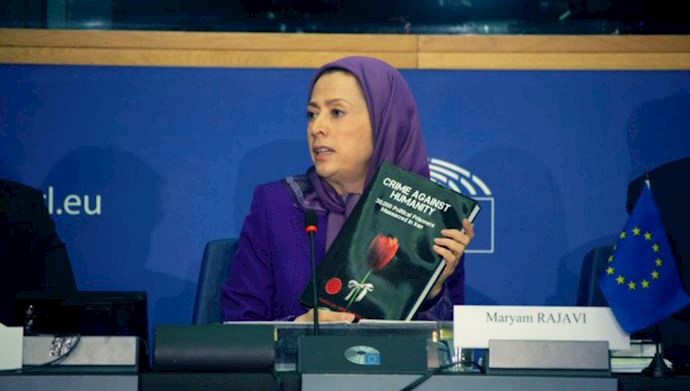Analysis by PMOI/MEK
Strasbourg, October 29, 2019—“This is not just a book containing the names of victims, but a historic testimony on how Iran has been taken hostage by the fascist medieval theocracy,” said Mrs. Maryam Rajavi, the president-elect of the National Council of Resistance of Iran (NCRI), in a conference at the European Parliament on October 23, where she introduced a newly published book about the massacre of Iranian political prisoners.
Crime against Humanity is a book containing the names of over 5,000 victims of the #1988massacre in #Iran, also addresses of the tombs & mass graves in 36 cities, names of members of 35 Death Commissions, & lists 110 cities where the massacre was carried out. pic.twitter.com/P8iJqAzXJo
— Maryam Rajavi (@Maryam_Rajavi) October 27, 2019
In 1988, Ruhollah Khomeini, then-supreme leader of the regime, ordered the purging of Iran’s prisons from political prisoners with ties to the People’s Mojahedin Organization of Iran (PMOI/MEK). After Khomeini’s order, the regime’s officials executed more than 30,000 prisoners, dominantly members, and supporters of the MEK.
The book, titled, “Crime Against Humanity,” the book contains the names of 5,000 of the victims of the 1988 massacre, as well as the details of regime officials and Death Commissions involved in the crime. One of several documents published about the gruesome event, the book sheds new light on what many human rights experts and jurists describe as a crime against humanity.
Despite more than three decades passing from the 1988 massacre, many questions remain about it, including the exact number of victims and the whereabouts of their graves. After the 1988 massacre, the regime engaged in widespread activities and suppression campaigns to prevent word of the massacre of MEK prisoners from spreading in Iran and across the world.
"MEK supporters commemorate 1988 massacre victims in different countries"#Iran#1988Massacrehttps://t.co/1suXsTtJlt
— People's Mojahedin Organization of Iran (PMOI/MEK) (@Mojahedineng) October 13, 2019
The regime banned all groups and individuals—including regime officials—from getting close to the 1988 massacre and even mentioning the event or the fate of the MEK prisoners it had executed. This lay the groundwork for denying the biggest crime the mullahs committed during their 40-year rule.
The regime’s first measure to hide the traces of its crimes was to dump the bodies of the executed prisoners in mass graves in remote and unknown locations. The goal was to prevent the real scale of the horrible crime from becoming exposed.
Regime officials then persecuted the families of the victims and prevented them from holding ceremonies or even mentioning or asking about the fate of their loved ones. Iranian authorities never told the families where the victims were buried. To this day, many families are still wandering in the deserts of Iran, searching for traces of their loved ones.
Iranian authorities also burned the files and pictures of the executed MEK prisoners, trying to deny that they ever existed. Those who tried to investigate the fate of the victims and were too inquisitive were either arrested or ended up disappearing like the victims of the 1988 massacre.
These were just parts of the crimes the regime committed against MEK families after it carried out the brutal 1988 massacre.
Years later, as the truth began to surface and people discovered some of the mass graves, the regime proceeded with cementing the mass grave sites in many cities to destroy all traces of its crime.
As a result of the regime’s widespread effort to hide the traces of the massacre of MEK prisoners, the real statistics of the 1988 massacre have never been published. Even after 31 years, we still don’t exactly know how many prisoners were executed in cities such as Tabriz, Urmia, Sanandaj, and Baneh. In cities such as Shiraz, Ahvaz, and Isfahan, where there were several prisons and many sources of information, exact figures have not been obtained. In many prisons, not a single survivor remained to recount the crimes the regime committed.
None other than the regime officials who were involved in the brutal 1988 massacre know the details of the crime the regime committed against the MEK.
For instance, out of the 100 prisoners buried in the Tazeh Abad cemetery of Rasht city, the names of 20 are known. In the same city, many other prisoners have been buried in secret mass graves. Their fates will only become known after the mullahs’ regime is overthrown.
According to accounts by eyewitnesses, the regime savagely mutilated many of the MEK prisoners in the courtyard of Urmia prison. Others were ruthlessly stuffed into bags and shot dead while thrown in mass graves.
Khomeini massacred thousands of MEK prisoners, and his successor, Ali Khamenei, tried to massacre their names and memories. This is a crime that continues to this day.
Under such circumstances, every single name and fact about the 1988 massacre is very important. Therefore, the publication of 5,000 names of MEK prisoners executed by the Iranian regime in 1988 is very significant and couldn’t have been possible without the relentless efforts of the MEK’s network inside Iran, who investigated and documented every bit of information with great risk to their lives.
Every MEK martyr whose name becomes known represents tens of others whose fate have yet to be determined.
In the European Parliament conference, Mrs. Rajavi said, “This book contains the names of more than 5,000 PMOI prisoners massacred by the mullahs in Iran. If I were to summarize the situation in Iran after 40 years of the rule of religious fascism, I would say: Iran is a massacred country where, in addition to political prisoners, its natural resources, culture and environment have all been massacred… It is the story of a nation suppressed by anti-human mullahs at home. Unfortunately, the outside world has ignored not only the violation of human rights and the suppression of freedoms, but also an organized resistance to this regime.”





